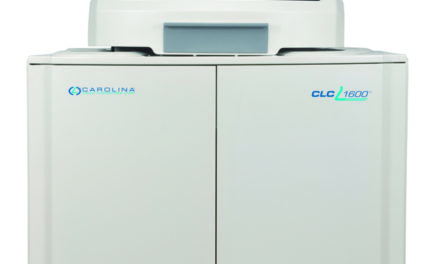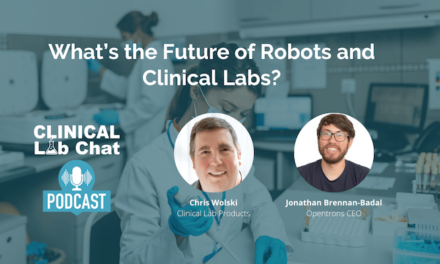With ongoing technologist shortages and growing demand, lab automation is a hot topic. URG may have found the formula for automation success.
By Chris Wolski
Kevin. Baxter. Sawyer. This isn’t what you’d typically expect to name a robot. But for the United Robot Group (URG), lab automation success and failure often boils down to just that: a name.
“Giving a robot a name leads to better acceptance,” explains Julia Riemenschneider, VP of business development for URG.
The company has even gone a step further, adding a “face” (see photograph above) in a use-case study being conducted in Finland. The goal to is humanize the robot, making it less of a perceived threat.
The need for robots and lab automation continues to climb as demand for laboratory services increases and personnel shortages continue. Along with ongoing retirements, 85% of lab professionals reported feelings of burnout in 2020, according to URG. Four years later the situation, if anything, may be getting worse.
To combat this, URG’s CobiotX solutions, KEVIN and uMobileLab, are designed to fill the gaps, helping in a number of ways, including improving inconsistent workflows, addressing the need for speed and accuracy, the challenge of repetitiveness, and covering a wide range of testing and tasks.
However, Riemenschneider notes that while there is an industry-wide desire for lab automation, a fundamental challenge remains.
“Customers and experts want to automate their labs, but can’t see the use case,” she says.
Of course, and no little thanks to apocalyptic science fiction films and poorly executed real-world implementations, lab automation—and automation across industries—is often perceived as something designed to put experienced professionals out of a job.
Riemenschneider acknowledges how this perception needs to change.
“Lab automation should be perceived as helping people and not as a means to take over,” she says.
This is part of the reason the company has done some anthropomorphizing of its lab automation products, and it’s working, according to Riemenschneider, noting that a name and human-like animated face has helped to minimize these fears and increased acceptance.
With six axis movement, URG’s Kevin even moves like a human—again helping to make the solution seem less like an alien usurper and more like a collaborator.
Humanized Lab Automation Overview
According to URG, KEVIN is an autonomous, mobile laboratory robot capable of automating processes, connecting to automation devices and bridging automation island and can be flexibly and intuitively integrated into laboratory infrastructures. The robot takes over repetitive routine tasks, including the transportation of microtiter plates and racks in SBS format, such as samples or consumables for refilling.
As an additional benefit, according to the company, KEVIN is a software agnostic device, facilitating its integration into third-party process management software and can communicate with most table-top automation devices and it is designed specifically for the SBS format.
uMobileLab is URG’s first lab robot design to interact with other robots and humans, and is a multipurpose solution designed to enhance patient care and staff satisfaction by improving efficiency, reducing workload, and freeing up highly qualified laboratory staff for high-value tasks while ensuring more precise results and faster turnaround times. uMobileLAB automates a range of laboratory operations, including routing specimens to multiple analyzers; racking specimens around the clock as well as loading, unloading; and operation of analyzers and other lab peripherals. According to URG, uMobileLAB reduces walking distances up to 70%, relieves lab talents during the peak hours, and significantly eases staffing requirements for weekend and night shifts.
uMobileLAB’s AI-powered system allows it to perform various tasks in the in-vitro diagnostics environment, such as handling, de-capping and pipetting, centrifuging, monitoring, delivering materialsa and navigating elevators and doors with ease. In an initial phase, uMobileLAB is compatible with lab functions in more than 850,000 hospitals, according to the company.
URG is committed to designing robots for humans, emphasizing that these solutions are tools designed to help humans do their jobs and not an end in and of themselves.
Chris Wolski is chief editor of CLP.
Featured Image: Robots designed for lab automation have better acceptance if they are anthropomorphized with common human names and facial features, according to URG. Photo: URG





